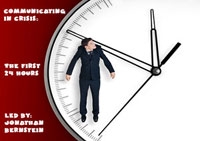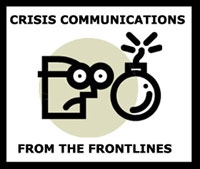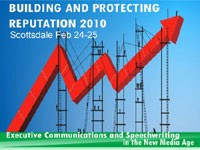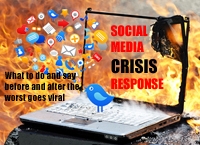Of course, the best way to manage a corporate crisis is to prevent it. But that’s another course.
In this class we are assuming, despite all the best crisis auditing and planning, something ugly has hit the fan, and all hell has broken loose, or so it may seem in those first few hours.
No matter how awful and mind-numbing the event, your job is to calmly slide into crisis mode and help your organization do and say the right things – promptly, compassionately and honestly. Those first 24 hours are critical because, now more than ever, your initial responses can sink or save your organization’s reputation and much more. Say the wrong things and your organization will be perceived as inept, at best, and criminally negligent, at worst. That’s why Communitelligence is producing this webinar with Jonathan Bernstein, noted crisis communication expert and author of the new book, Manager’s Guide to Crisis Management.
Attend and you’ll more fully grasp any situation that threatens your business, your career, and even lives. By mastering the most effective tactics, you’ll be able to lead through any crisis smoothly and with minimal ramifications.
What You Will Learn:
- The biggest mistakes in crises communications
- Preparing for the three types of crises
- When to initiate a crisis response and when to “Shut the hell up”
- What makes a good spokesperson
- The 5 tenets of crisis communications
- Messaging: the 3 C’s of crisis credibility
- The importance of holding statements
- How and when to speak directly to your stakeholders
- The forgotten stakeholders – internal communication
Presented by:
 Jonathan L. Bernstein, president of Bernstein Crisis Management, Inc. has more than 25 years of experience meeting clients’ needs in all aspects of crisis management – crisis response, vulnerability assessment, planning, training and simulations. Prior to launching his firm in January 1994, Bernstein created and served as the first director of the Crisis Communications Group for Ruder Finn, Inc., one of the world’s largest public relations agencies.
Jonathan L. Bernstein, president of Bernstein Crisis Management, Inc. has more than 25 years of experience meeting clients’ needs in all aspects of crisis management – crisis response, vulnerability assessment, planning, training and simulations. Prior to launching his firm in January 1994, Bernstein created and served as the first director of the Crisis Communications Group for Ruder Finn, Inc., one of the world’s largest public relations agencies.
Bernstein is publisher and editor of Crisis Manager, a first-of-its-kind email newsletter written for “those who are crisis managers whether they want to be or not,” currently read in 75 countries, and author of the most popular crisis management blog online. His commercially published Keeping the Wolves at Bay: Media Training has been as “an outstanding foundation for preparing individuals and organizations for effective crisis management.” His newest book, Manager’s Guide to Crisis Management (McGraw-Hill) was published in November 2011. Bernstein is frequently interviewed by national and international media outlets about various “crises du jour.” A PR Week feature story entitled “The Crunch-Time Counselors” identified Bernstein as one of 22 “people who should be on the speed dial in a crisis” and Business Week featured his perspectives in an article entitled “Masters of Disaster.”
Who Should Attend
- Crisis managers in corporate communications, public relations, corporate affairs, human resources, employee communications, media relations, and issues management.
Learn the necessary components of a crisis preparedness plan and how to effectively communicate it.
Terrorism, natural disasters and human errors observe few rules, and your company may be hit without any warning whatsoever. How badly your business is disrupted — and how much public trust and confidence remain with the company — will depend on how prepared you and your senior managers are when it comes to crisis communications.
Is your company prepared for a crisis? Does your company’s existing crisis policies allow for the smooth running of operations and communications in the event that something goes wrong? This session explores what communicators must do to help their companies survive the worst.
What You Will Learn:
- Crisis assessment or audit
- Writing the crisis plan and key messages
- The elements of a sound crisis communication plan
- Case study: Hurricane Katrina
- Crisis drill
- Emergency preparedness and response
- Crisis communications leadership
- Steps you should take
- Selling the need for crisis communications planning
- Crisis planning for operations abroad
After reviewing this webinar, you will have:
- A better understanding of the necessary dynamics of a crisis preparedness plan and how it can help your business survive the most difficult of times
- The necessary components of a crisis preparedness plan and how to it can be communicated effectively across the company
- the know how to execute your communication program if the power goes out
- The know how to write key messages that will withstand a crisis
- Understanding how the news media will respond to a crisis situation
- What it takes to take control of the situation and avoid unnecessary escalation by the media
- What you, as a communicator, can do to help the organization resume normal operations – ASAP!
Instructor:
 Gerard Braud cut his teeth in the crisis arena as a front-line journalist for 15 years, covering events that included one of the nation’s deadliest train derailments, one of the worst federal prison riots and some of the country’s worst industrial accidents and natural disasters. As the head of Braud Communications, he has created proven methods to help organizations communicate with the media, employees and other stakeholders during a crisis. After the events of September 11, 2001, Gerard was commissioned to write the crisis communications plan for the Internal Revenue Service and its 800 offices across the U.S. A native of Louisiana, Gerard prepared a crisis communication plan for the City of New Orleans in 2002 that was rejected due to lack of funding.
Gerard Braud cut his teeth in the crisis arena as a front-line journalist for 15 years, covering events that included one of the nation’s deadliest train derailments, one of the worst federal prison riots and some of the country’s worst industrial accidents and natural disasters. As the head of Braud Communications, he has created proven methods to help organizations communicate with the media, employees and other stakeholders during a crisis. After the events of September 11, 2001, Gerard was commissioned to write the crisis communications plan for the Internal Revenue Service and its 800 offices across the U.S. A native of Louisiana, Gerard prepared a crisis communication plan for the City of New Orleans in 2002 that was rejected due to lack of funding.
 Brenda Siler has 30 years of experience in leading communication programs in a variety of U.S.-based nonprofits and associations, including the American Speech-Language-Hearing Association, the American Red Cross, United Way and AARP. She is a past chairwoman of IABC. While serving as the director of external communications at the American Red Cross, Brenda developed a crisis communications plan for the its Metro Atlanta Chapter, which was used for a threatened nurses strike, local/regional disasters and queries about HIV and the safety of the blood supply. She also coordinated communications efforts for United Way’s role in the Atlanta “Missing and Murdered Children” crisis, including managing pro bono services of local advertising and PR agencies. Based in Silver Spring, Md., Brenda is certified by the American Red Cross in disaster public relations management.
Brenda Siler has 30 years of experience in leading communication programs in a variety of U.S.-based nonprofits and associations, including the American Speech-Language-Hearing Association, the American Red Cross, United Way and AARP. She is a past chairwoman of IABC. While serving as the director of external communications at the American Red Cross, Brenda developed a crisis communications plan for the its Metro Atlanta Chapter, which was used for a threatened nurses strike, local/regional disasters and queries about HIV and the safety of the blood supply. She also coordinated communications efforts for United Way’s role in the Atlanta “Missing and Murdered Children” crisis, including managing pro bono services of local advertising and PR agencies. Based in Silver Spring, Md., Brenda is certified by the American Red Cross in disaster public relations management.
 Joseph Honick is president of GMA International Ltd. Since 1975, his consulting firm has assisted organizations, nonprofit associations and major educational institutions with crisis management and communication efforts. His firm also works to broaden business opportunities abroad for major U.S. corporations. His firm is based Tucson, Ariz.
Joseph Honick is president of GMA International Ltd. Since 1975, his consulting firm has assisted organizations, nonprofit associations and major educational institutions with crisis management and communication efforts. His firm also works to broaden business opportunities abroad for major U.S. corporations. His firm is based Tucson, Ariz.
Presentation from Essential Social Media Skills Practicum at Georgia Institute of Technology

Social Media is replacing the 24 hour news cycle with the 140 character (Twitter) news cycle. Every crisis communications plan is now riddled with fatal flaws and due for a major rewrite.
- Secrets to speed in crisis communications
- Fatal flaws in most crisis communications plans
- Implications of Social Media, friend and foe
- Communications conundrums of Social Media
 Gerard Braud (Jared Bro) has pioneered new ways to speed you through both crisis communications and the process of writing a crisis communications plan. Since 1994, Gerard has practiced his craft on four continents as an expert in crisis communications and media training. Prior to 1994, Gerard spend 15 years as an award winning frontline journalist with report seen around the world on NBC, CBS, CNN and the BBC.
Gerard Braud (Jared Bro) has pioneered new ways to speed you through both crisis communications and the process of writing a crisis communications plan. Since 1994, Gerard has practiced his craft on four continents as an expert in crisis communications and media training. Prior to 1994, Gerard spend 15 years as an award winning frontline journalist with report seen around the world on NBC, CBS, CNN and the BBC.
Who Should Purchase
- Individuals responsible for corporate communications, public relations, corporate affairs, human resources, employee communications, media relations, and issues management.
Testimonials:
- “It has been awhile since I’ve left a seminar (webinar, teleseminar, in-person, etc.) feeling, ‘Wow, I’m walking away with some new nuggets of insight I can put in place to help me up my game – and impact my clients in a positive way.’ So kudos to Gerard Braud for a great teleseminar on ‘Writing Your Crisis Comm Plan for the New Social Media Reality‘ and bringing to bear new ways of tackling an age-old bastion of public relations – the Crisis Communication Plan.” Jessica Flynn, Principal, Red Sky Public Relations in PR Musings Weblog.
- “Timely information, clear presentation, nice slides.”
- “We want to pilot the use of social media in our crisis planning process and this was good information to have.”
This session will identify and describe the actions companies and their leaders can take to safeguard their corporate reputations, and rebuild their reputations and restore their good names after a crisis.
 Jon HarmonJon Harmon is a communications consultant and author. He founded Force for Good Communications, a consultancy offering services ranging from brand-building media relations to crisis communications. His book on crisis communications, Feeding Frenzy: Inside the Ford-Firestone Crisis, was published in October, 2009. Previously, Jon was vice president – Communication and Reputation at Navistar, a global manufacturer of commercial trucks and military vehicles.
Jon HarmonJon Harmon is a communications consultant and author. He founded Force for Good Communications, a consultancy offering services ranging from brand-building media relations to crisis communications. His book on crisis communications, Feeding Frenzy: Inside the Ford-Firestone Crisis, was published in October, 2009. Previously, Jon was vice president – Communication and Reputation at Navistar, a global manufacturer of commercial trucks and military vehicles.
Jon’s career includes 23 years at Ford Motor Company in virtually every aspect of public relations, including media relations, employee and dealer communications, governmental affairs, issues management, product promotion, crisis communications and communications strategy.
The Force for Good blog is centered on the conviction that reputation is a company’s greatest asset, and that doing the right things in terms of corporate social responsibility can lead directly to success in the market. The most effective means of protecting and enhancing reputation is a consistent dedication to “aspirational public relations” built on transparency, honesty, integrity and social responsibility.
BP, Dominos, United Airlines, Dole, Dell, Sony … these days you can hardly name a company that hasn’t faced — and fumbled — a social media crisis.
We’re not being critical here, just sounding the siren for a crisis fire drill. No company large or small is immune from the unexpected, yet semi-inevitable crisis that can be ignited on a social network by a single customer complaint or mishap.
With your brand and reputation at stake, the impulse is to fight fire with fire, or to bury your head and not respond at all. That’s why having a fire-proof social media crisis framework in place is absolutely critical. And of course, the time to develop your plan–and your strategy–is now, before your next oil spill.
In this special webinar, our three battle-tested crisis experts will dissect what can go wrong so quickly. Coming from their unique vantage points, they will help you and your team set up practices and processes that are often overlooked in basic social media crisis response plans … techniques that will help you stay calm when the worst goes viral.
What You Will Learn:
- Lay of the landscape: How corporate crisis communications and response tactics have been forever changed by social media
- Essential lessons from the best and worst social media crisis responses
- How to create a social media response flowchart – and why you need one
- How to assess the issues
- With the clock ticking, tactics on engaging quickly, smartly and calmly, or not responding at all
- Who says and does what: assigning roles and responsibilities, and including internal communications
- How to conduct an audit of issues that could go viral, and prepare response templates
- Understanding the basic rules of social media crisis management, and how each channel is different
Presented by:
 Frank Eliason, Citibank’s senior vice president of social media, has been described as the “most famous customer service manager in the U.S., possibly the world.” Prior to joining Citibank, Frank was best known to many as the voice behind @ComcastCares, one of the earliest examples of how a business can use social networks to proactively listen and respond to customer concerns in real-time. This work has been recognized by many news organizations such as ABC News, CNN, The New York Times, Business Week, and many others. He is also one of the most sought-after thought leaders on social media and customer experience, and regularly participates in panels and speaking engagements. He is author of At Your Service: How to Attract New Customers, Increase Sales, and Grow Your Business Using Simple Customer Service Techniques.
Frank Eliason, Citibank’s senior vice president of social media, has been described as the “most famous customer service manager in the U.S., possibly the world.” Prior to joining Citibank, Frank was best known to many as the voice behind @ComcastCares, one of the earliest examples of how a business can use social networks to proactively listen and respond to customer concerns in real-time. This work has been recognized by many news organizations such as ABC News, CNN, The New York Times, Business Week, and many others. He is also one of the most sought-after thought leaders on social media and customer experience, and regularly participates in panels and speaking engagements. He is author of At Your Service: How to Attract New Customers, Increase Sales, and Grow Your Business Using Simple Customer Service Techniques.
 Cynthia Martinez is the Director of Global Corporate Communications for Royal Caribbean Cruises Ltd., a global cruise vacation company that operates five major cruise brands, including Royal Caribbean International and Celebrity Cruises. The company has a total of 40 ships in service throughout the world one under construction and one under agreement. While at Royal Caribbean, Ms. Martinez has provided communications guidance and counsel during crisis situations involving issues such as: environmental, litigations, health & medical, weather, marine and hotel operations, onboard accidents and alleged crimes. Most recently, Ms. Martinez led Royal Caribbean’s overall national and international communication strategy for the company’s return to Haiti after the earthquake
Cynthia Martinez is the Director of Global Corporate Communications for Royal Caribbean Cruises Ltd., a global cruise vacation company that operates five major cruise brands, including Royal Caribbean International and Celebrity Cruises. The company has a total of 40 ships in service throughout the world one under construction and one under agreement. While at Royal Caribbean, Ms. Martinez has provided communications guidance and counsel during crisis situations involving issues such as: environmental, litigations, health & medical, weather, marine and hotel operations, onboard accidents and alleged crimes. Most recently, Ms. Martinez led Royal Caribbean’s overall national and international communication strategy for the company’s return to Haiti after the earthquake
 Pat Philbin has extensive executive level experience in leading, managing and participating in large scale, high-profile events, including, but not limited to, loss of the space shuttle Challenger in the mid-1980s, mass migrations of Haitians/Cubans in the early 1990s, the loss of TWA Flight 800 and Alaska Air, the loss of JFK, Jr.’s aircraft off of Martha’s Vineyard, and dozens of contentious and complex business and legislative issues associated with FEMA’s transformation following Hurricane Katrina. Pat is CEO of Crisis1 and serves as a member of Firestorm Solutions Expert Council, a company focused on business continuity, vulnerability analysis, risk mitigation and crisis management. He is also a member of Homeland Security Outlook’s Advisory Board.
Pat Philbin has extensive executive level experience in leading, managing and participating in large scale, high-profile events, including, but not limited to, loss of the space shuttle Challenger in the mid-1980s, mass migrations of Haitians/Cubans in the early 1990s, the loss of TWA Flight 800 and Alaska Air, the loss of JFK, Jr.’s aircraft off of Martha’s Vineyard, and dozens of contentious and complex business and legislative issues associated with FEMA’s transformation following Hurricane Katrina. Pat is CEO of Crisis1 and serves as a member of Firestorm Solutions Expert Council, a company focused on business continuity, vulnerability analysis, risk mitigation and crisis management. He is also a member of Homeland Security Outlook’s Advisory Board.
Who Should Attend
- This webinar is specially geared for PR, marketing, sustainability, corp comms and internal comms, legal, customer service, marketing and issues management professionals.
Attendee testimonial:
- “This was a reminder that the gaps we previously identified needs to be worked. Some of the specific information re Facebook, Twitter and dealing with negative comments and social media policy was very helpful.”
This webinar by James E. Lukaszewski, one of America’s most thoughtful and visible crisis advisors, will take participants through a high level strategic discussion of the crucial elements of crisis readiness. Lukaszewski defines a crisis as, “a people-stopping, show-stopping, product-stopping, reputation-redefining and trust-busting event that creates victims and/or explosive visibility.”
 While his initial response strategy discussion will focus around his five crucial steps to take during the golden hour of crisis, he’ll also talk extensively about readiness and avoiding the most predictable gaffs and problems that can torpedo even a well-designed and practiced response process.
While his initial response strategy discussion will focus around his five crucial steps to take during the golden hour of crisis, he’ll also talk extensively about readiness and avoiding the most predictable gaffs and problems that can torpedo even a well-designed and practiced response process.
Lukaszewski will talk about the readiness process, what leaders should be doing when crises occur, as well as how to prevent crisis; the crucial missing ingredients of most crisis plans; victim management; response triggers; what you do first; the ideal grand response strategy; how to forecast your greatest vulnerabilities; and how managers can recover their leadership and the organization’s reputation as they respond appropriately during these powerful events.
Crisis situations present extraordinary threats to organization leadership and reputation. Much crisis readiness activity is geared toward managing the explosive media coverage that often occurs when crises erupt.
What you will learn:
- The five crucial steps to take during the golden hour after crisis erupts
- The seven crucial tests any readiness plan must pass to effectively manage crisis and recover your reputation
- The seven crisis response failure profiles and how to avoid them
- The four crucial things leaders need to do when crisis occurs
- The seven mistakes and gaffs leaders need to avoid
- A perfect response communicated poorly will always be remembered as a poor response
James E. Lukaszewski is the author of a dozen books and manuals on crisis management, being a trusted advisor, and overcoming various crisis situations. He’s a member of the Crisis Management and Business Continuation Council (CMBCC) of ASIS, and has served on several ASIS standard setting task forces, including Workplace Violence. Corporate Legal Times described Jim as, “one of 28 crisis experts who should be on your speed dial when all hell breaks loose.” PR Week describes him as, “one of 24 crunch-time counselors who needs to be at your fingertips when crises occur.” In 2013, Trust Across America listed him as one of the “Top 100 Thought Leaders in Trustworthy Business Behavior.” Jim’s clients will tell you that his strategy of doing things quickly, that are simple, sensible, constructive and positive is a powerful formula for success and reputation protection.
His latest book, Lukaszewski on Crisis Communication, What Your CEO Needs to Know About Reputation Risk and Crisis Management, released in March 2013, is now available at Amazon.com. You can follow James on Twitter and read hisCrisis Guru blog.
Social media is a two-edged sword. We tend to only talk about the positive side — how social channels creatively deployed can greatly expand your organization’s marketing reach. Not much attention is paid to the dark, destructive side of social media — how a single customer complaint ignite a firestorm sweeping the Web and causing the most hardened organizations to panic. What to do? What to say?
This webinar explains the dynamics of customer activism in today’s democratized media world. It offers practical, actionable avoidance and response strategies for business executives and professional communicators. It also outlines processes to building an attack-proof culture that centers on customer satisfaction.
The good news is that bad buzz can be countered by earnest and savvy customer engagement. You can actually turn the angriest customers into raving fans.
“Great information that I can share with others who handle social media. Very informative and loved hearing the case studies.”
What You Will Learn:
- Why common business responses to customer complaints often make matters worse;
- Why complaining customers can be some of an organization’s most valuable assets;
- How vocal critics can be turned into raving fans with an active response strategy;
- How to manage and respond to comments on customer review sites;
- Customer support strategies for Facebook and Twitter;
- How to organize a team to identify and respond to attacks in minutes; and
- How to create a culture that puts customers first.
Who Should Attend
This webinar is designed for everyone who would like to help their organizations react to any online crisis that might erupt. It is especially suitable for:
- Brand managers, marketers, PR pros, social media managers, communications department staffers, public affairs, security, employee communications, media relations and issues management professionals.
Presented by:
 Paul Gillin is a veteran technology journalist and a thought leader in new media. Since 2005, he has advised marketers and business executives on strategies to optimize their use of social media and online channels to reach buyers cost-effectively. He is a popular speaker who is known for his ability to simplify complex concepts using plain talk, anecdotes and humor.
Paul Gillin is a veteran technology journalist and a thought leader in new media. Since 2005, he has advised marketers and business executives on strategies to optimize their use of social media and online channels to reach buyers cost-effectively. He is a popular speaker who is known for his ability to simplify complex concepts using plain talk, anecdotes and humor.
Paul is a prolific writer who has written five books and more than 200 published articles since 2007, in addition to two blogs. His award-winning 2007 book, The New Influencers, chronicled the changes in markets being driven by the new breed of bloggers and podcasters. His most recent book is Attack of the Customers. It documents the increasing incidence of online customer negativity and tells of businesses can avoid being victimized.
















